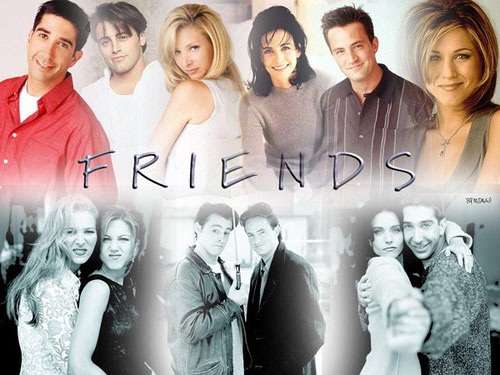當前位置: Language Tips> 雙語新聞
How Friends is already the relic of a bygone era
分享到

|
Friends ended less than a decade ago, but it's already a relic of a bygone era--a critically respected network sitcom that enjoyed massive ratings. That's the central irony of the Must-See TV show's legacy: It was one of the last programs to enjoy a national audience before cable and the Internet fully segmented audiences, but the show itself prophesied that fragmentation through its 10-year-long portrait of increasing social segregation. Friends started out as a somewhat realistic (for network TV) exploration of metropolitan young (white) people, in the same way Roseanne sought to capture (white) working-class Midwestern life. In their original treatment, creators David Crane and Marta Kauffmandescribed the show as a look at "a time in your life when everything's possible," when the future was "more of a question mark." It was a Girls before Girls--Monica and Rachel are 24 when the show begins, just like Lena Dunham's Hannah--but much more optimistic because the economy hadn't yet vomited all over itself after another binge-and-purge cycle. Thus, it's no coincidence that so many of the complaints lodged against Friends--unrealistically expensive lifestyles, pervasive whiteness, youthful frivolity, all that sex--are now being recycled by the anti-Dunham crowd. Crane and Kauffman contrasted their show against traditional living-room and workplace sitcoms with a then-innovative, now-rote concept. "It's about friendship, because when you're single and in the city, your friends are your family," read the original pitch to NBC. (The peacock execs were apparently so uncomfortable with the idea of a show about twentysomethings that they suggested the creators add a middle-aged man to dole out fatherly advice. Perhaps that explains that NBC also-ran sitcom where Ernest Borgnineplayed Jonathan Silverman's BFF?) The great achievement of Friends' 10 seasons is that Crane, Kauffman, and executive producer Kevin S. Bright convincingly carried the sexy sextet through several life stages: marriage, parenthood, divorce, and the rocky, too-often humiliating road to a fulfilling career. But as the seasons progressed and its mythology expanded, the show shriveled, folding into itself. At the same time, the storylines became increasingly outlandish--the nadir of the head-scratching plots being Joey and Rachel's doomed romance--yet still somehow more depressingly realistic. The source of these two phenomena lay in the show's illustration that, as doors shut in your face during your twenties, you're not just increasingly penned in professionally, but also personally. The overarching narrative ofFriends charts how its characters' lives got smaller and narrower until they could no longer comfortably accommodate their makeshift friend-families--just a spouse and a child or two. Kauffman articulated the show's ethos of "maturity means friends or children" whenshe denied rumors of a follow-up to the show earlier this year. "Friends was about that time in your life when your friends are your family," she explained. "Once you have a family, there's no need anymore." To be fair, most sitcoms function as narrative islands. But from the start, Friends had sociological aspirations, making its observations of life as a post-collegiate lost soul in the big city more significant and purposeful than its time-slot neighbors likeSeinfeld and Frasier. And during the early years, there were good reasons for the sextet to stick so closely together. In the first two seasons, when the show hewed to its slice-of-life ambitions, money was a constant source of anxiety. Friendsimplied that the high cost of fun made a lot of activities off-limits; its New York was never the playground of luxury and fashion that is Sex and the City's Manhattan, not even for clotheshorse Rachel. Early in the second season, the show had its most explicit episode about income and friendships, where three of the have-not Friends--Phoebe, Rachel, and Joey--balk at their better-earning counterparts' plan to buy Hootie and the Blowfish tickets (heh) for Ross's birthday. Say what you will about the sextet's caffeine addiction--Scientific American certainly did--but those venti mugs probably didn't exceed $5. Since both lattes and talk are cheap, Central Perk kept the Friends together by offering itself as an economic oasis. The characters mostly take advantage of their urban environs by treating them as one long speed-dating assembly line. Friends relied heavily on the sitcom cliché of the Significant Other of the Week, a plot device that inevitably resulted in the SOW being dumped by the end of the episode, though some lasted a month or two. Especially in the earlier episodes, SOWs were routinely cast off because one of the other Friends disliked them. Over time, the repetition of the SOW storylines served to foster a loyal conformity among the Friends, as well as the creation and enforcement of a particular strand of promiscuous, gay-panicked, white-privileged, yuppie heterosexuality. The decade-long accumulation of rejected romantic partners eventually turned Friends' New York from a marketplace of possibilities to a menagerie of freaks, thus providing further incentive to stick to the clique. It makes sense that Phoebe, who marries Paul Rudd's Mike in the last season, was the exception to the rule, since she has the most tenuous connection to the rest of the characters. (According to Splitsider, she is also the only character who doesn't share a previous sex partner with any of her Friends.) By the show's end, having gone through all of white Manhattan, four of the six characters settle down with a mate from within their group. For all the cosmopolitan setting, then, the Friends eschew the romance of urban serendipity for incestuous familiarity. (This also explains the characters' lack of interest in people of other races--or even other boroughs.) Like a lot of ensemble sitcoms about single characters, Friends eventually becomes a screed against dating. The parade of flawed, unworthy, or just-not-right partners is so long that settling down with (and for) a good friend ultimately seems like the most sensible choice: better the Long Island Princess you know than the one you don't. (The Friendscopycat How I Met Your Mother goes even further in this regard by making its protagonist's two decades of dating merely a prelude to his wedded destiny, and explaining away its most promiscuous character's obsession with sex as the product of severe neurosis.) By the end of its run, the show groups its couples essentially by census bracket. The pairing of Monica with Chandler and Ross with Rachel unite the friends who are the most financially and ethnically similar (Rachel and the Gellar siblings are Jewish; Chandler is the Jew-adjacent kind of goy). Across town, masseuse Phoebe marries musician Mike, her "rightful" partner in anti-bougiedom. Friends has often been accused of being cash-stupid show--e.g., Monica and Rachel live in a huge West Village apartment despite no outward signs of being millionaires--but it's always been a very class-conscious one. Opposites may attract, but familiars breed. The ultimate sign of the show's tenet of "settling down as settling for who's around" is the reunion of the will-they-now-or-will-they-later couple, Ross and Rachel. It's a pairing that only worked in the early years because of David Schwimmer's hangdog eyes, and the relationship's initial dissolution was rather welcome, not least for bringing out a sarcastic edge and a screechy feistiness in Jennifer Aniston. Despite the characters' mutual attraction, they were always wrong for each other: Ross deserves a partner who's more intellectually challenging, Rachel one who's more fun. When they create a child and rekindle their romance in the show's last two seasons, their happy ending feels like a tragic death--of adventure, of idealism, of question marks. No longer so young, and yoked together by their kid, they see sense in trying to fall in love again, however many times it didn't work before. Their fate isn't written in the stars; it's dictated by two much more powerful forces: convenience and familiarity. |
《老友記》完結至今雖僅十年,卻已成為一個逝去時代的遺產。作為最后幾部國民級的劇集之一,《老友記》有著廣大的觀眾群體,備受人們推崇和喜愛。在網絡出現(xiàn)并開始與電視臺爭奪觀眾群之后,社會隔離現(xiàn)象逐漸加劇,這類“國民劇集”也開始銷聲匿跡。《老友記》的存在顯得格外諷刺:長達十年的時間里,它對社會隔離現(xiàn)象的發(fā)展進行了細致的描繪,在某種意義上預言了這一隔閡的出現(xiàn)。(社會隔離:處于一種原有的社會聯(lián)系逐漸減少以至于與社會隔離的狀態(tài)) 與《羅西尼》中對中西部白人工人的刻畫類似,《老友記》以寫實的方式描繪了都市白人青年的生活狀態(tài)。在最初的劇本大綱里,編劇大衛(wèi)·柯拉尼和瑪塔·卡夫曼將《老友記》定位為一部“表現(xiàn)人們生命中一段一切皆有可能的時期”的作品,在這段時期里,未來“就是大大的一個問號”。和《都市女孩》(Girls)中麗娜·杜漢姆飾演的漢娜類似,莫妮卡和瑞秋在劇集開始時都是24歲。但是相較而言,《老友記》中女孩的形象要更加樂觀,因為當時經濟還沒有像后來的次貸危機時一樣,因為過度低信用放貸而一發(fā)不可收拾。這也解釋了許多人對《老友記》的質疑。就像他們不喜歡的《都市女孩》一樣,《老友記》中不符合事實的昂貴生活作風,四處都是白人的社會環(huán)境,輕浮的年輕人,亂七八糟的性愛觀,都讓他們感到不快。 對比過去的客廳-辦公室式情景喜劇,柯拉尼和卡夫曼采用了一種全新的即時創(chuàng)作手法,表現(xiàn)當下流行的種種觀念。NBC最初把這部劇主題定位為“友誼”:當你孤身一人在大城市里,你的朋友就是你的家人。(那些高管們明顯對于這個有關二十幾歲年輕人的劇不滿意,他們建議給劇中增加一些中年人的角色,以便適當?shù)臅r候提出一些成熟的意見。這可能就是為什么NBC的另一部喜劇《The Single Guy》中,恩尼斯特·伯格尼演了喬納森·斯利文曼的鐵桿好友)。十年間,《老友記》的最大的成就莫過于兩位編劇和制片人讓這充滿魅力的六人組攜手經歷人生種種:結婚,生子,離婚,艱難而曲折的追求自己的事業(yè)。 劇集一季接著一季登上熒幕,人氣也越來越旺,可是劇情卻開始變得干癟無趣。故事情節(jié)莫名其妙,尤其是喬伊和瑞秋之間注定失敗的感情線,至今都能讓人感受到其中苦澀的現(xiàn)實感。這些現(xiàn)象讓我們意識到,隨著角色們年齡增長并進入二十歲后半,他們的職業(yè)和生活也將逐漸被各種條條框框所束縛,不像往日般自由而有趣。隨著他們的生活逐漸穩(wěn)定,娶妻生子,交際的圈子也變得越來越小,以至于到最后,沒有一個人能很好的處理朋友與家庭的關系。 卡夫曼否認了《老友記》會推出后續(xù)電影的說法。“這部劇集講的就是‘朋友即家人’的這樣一個特殊的時期。”她解釋道,“而一旦人們擁有了自己真正的家庭,這樣的時期也就永遠過去了。“ 大多數(shù)情景喜劇只是在簡單的呈現(xiàn),而《老友記》則從一開始就試圖反映社會現(xiàn)實。它從一群剛剛畢業(yè)在城市里闖蕩、內心迷茫的年輕人視角觀察這個社會,并且以他們的方式將其呈現(xiàn)出來。與同時期的《宋飛正傳》(Steinfield)和《歡樂一家親)(Frasier)相比,這部劇顯得更加具有社會意義。六個年輕人相互扶持,共同成長,在剛踏入社會時也非常有必要。 在前兩季,《老友記》還堅持著反映現(xiàn)實的初衷,劇中主要困擾角色們的問題大多與金錢相關。誠然,他們所生活的紐約不是《欲望都市》(Sex and the City)中的曼哈頓,不是奢侈和時尚的游樂場,昂貴的消費水平使得許多娛樂活動受到限制,就連嬌生慣養(yǎng)的瑞秋也不能大手大腳的花錢。第二季第五集以一種近乎露骨的方式表現(xiàn)了收入和友誼的關系——三個高收入的老友提出購買貓頭鷹和河豚魚樂隊的演唱會門票作為羅斯生日禮物,而菲比、瑞秋和喬伊這三個窮光蛋則一直在試圖回避這一話題。在劇中,這六個人咖啡的確喝的不少,且不管你如何看待這種行為(這是《科學美國人》的活兒),聚在一起喝咖啡絕對是一種便宜的聯(lián)絡感情方式。這樣一杯咖啡,即便用劇中那種超大號的杯子,價錢也不會超過五美元。不用花什么錢,老友們就可以聚在一起和拿鐵,侃大山。 住在城市里的一大好處就是戀愛機會源源不斷。老友們像速配生產線一樣閃電般的和不同的人約會。《老友記》使用了情景喜劇中的慣用套路:角色們的戀愛時間不會超過一個星期,本周的戀人無一例外的在該集結束后被甩掉。尤其在早期的劇集中,僅僅是因為其他老友們不喜歡某些”快餐戀人”,他們便會被老友們齊心協(xié)力的驅逐出劇。隨著劇情的發(fā)展,這樣的劇情一再上演,導致劇中逐漸形成了一種崇尚隨性而為、反同性戀,且以白人主導的中上階層青年戀愛風潮。 經過了十年間種種毫無意義的分分合合,紐約這個原本充滿機遇的城市在觀眾看來儼然成了一幫被甩怪人的聚集地,這也使得老友們更加鐘情于自己的小群體。這樣看來,最后一季中菲比嫁給保羅·路德飾演的邁克也顯得挺正常。作為唯一一個沒有內部消化的老友,菲比是一個合情合理的例外。她與這個小團體的聯(lián)系的確沒有其他老友般深刻。(據Splitsider——國外一喜劇創(chuàng)作者網站分析,菲比是小圈子中唯一一個沒有和其他老友擁有共同性伴侶的角色。) 在最后,在感受過曼哈頓各種類型的白人后,四個老友內部消化了。即便大都市中有這么多各式各樣的人,這些老友們仍然放棄了都市邂逅的陌生浪漫,選擇尋求老友間近乎亂倫的熟悉感。(這種心理也解釋了為什么他們對其他種族甚至其他地區(qū)的人毫無興趣。) 就好像許多圍繞單身人物展開的情景喜劇一樣,《老友記》也開始批判毫無意義的約會行為。在經歷了一幫錯誤的不值得的有緣無分的伴侶后,老友們最終還是選擇了身邊的朋友。這樣的選擇看起來相當明智:熟悉的長島公主怎么說也比陌生的性伴侶要來的好。(模仿《老友記》的《老爸老媽浪漫史》更加深入的討論了這個問題。主角和種種不同的人談了二十年戀愛才最終踏入婚姻殿堂。這部劇將種種濫交的行為解釋成嚴重神經官能癥的產物。) 在大結局中,幾對伴侶的分組都有恰當?shù)囊罁D菘ê湾X德勒,羅斯和瑞秋這兩對的結合是出于經濟情況和價值觀念的契合。(瑞秋和蓋勒兄妹都屬于猶太教,而錢德勒雖然不是猶太教徒,但是在思維上與猶太教相近)菲比嫁給了音樂家麥克,他們在反社會地位主義上的立場使他們走到了一起。《老友記》常常因為角色與現(xiàn)實不符的經濟情況而受人責難——莫妮卡和瑞秋住在紐約西區(qū)的一處大公寓里,這樣豪華地段的住宅通常只有百萬富翁才負擔的起。就階級層面來說,這種現(xiàn)象也令人疑惑。條件相差許多的兩人可能會互相吸引,但是只有在各方面相似的人才會最終走到一起。 而最能體現(xiàn)出該劇“為身邊之人駐足”這一主旨的,當屬羅斯和瑞秋的復合。在觀眾看來,這對分分合合的小情侶在一起永遠只是時間問題。他們倆在早期曾經在一起過。羅斯可憐巴巴的眼神令人同情,而瑞秋則顯得歇斯底里又無理取鬧,所以兩人最初分手的時候,觀眾還挺滿意。 盡管兩人相互吸引,但他們卻并不相配:羅斯應該找個更加聰明的姑娘,而他對于瑞秋而言又顯得過于無趣。但是在最后兩季,在有了孩子后,他們又開始試圖尋回他們之前浪漫的感情。他們終成眷屬,組成家庭,只是這一看似圓滿的結局,更像是一場悲劇的終末——年輕的冒險、理想、種種未知數(shù)都已消失不見。不再年輕的他們僅僅因為孩子的存在而試圖喚醒那根浪漫的神經,可是他們如何能成功?他們的人生不再如同浩瀚星海般廣闊無垠,不可捉摸,而是被兩種力量牢牢束縛:習慣與熟悉。 (譯者 leewh 編輯 丹妮) 掃一掃,關注微博微信
  |
上一篇 : 科學家發(fā)現(xiàn)絕佳購物音樂
下一篇 : 福布斯排行榜:倫敦成為全球最具影響力城市
分享到
關注和訂閱


關于我們 | 聯(lián)系方式 | 招聘信息
電話:8610-84883645
傳真:8610-84883500
Email: languagetips@chinadaily.com.cn